Edward Teach, nicknamed Blackbeard
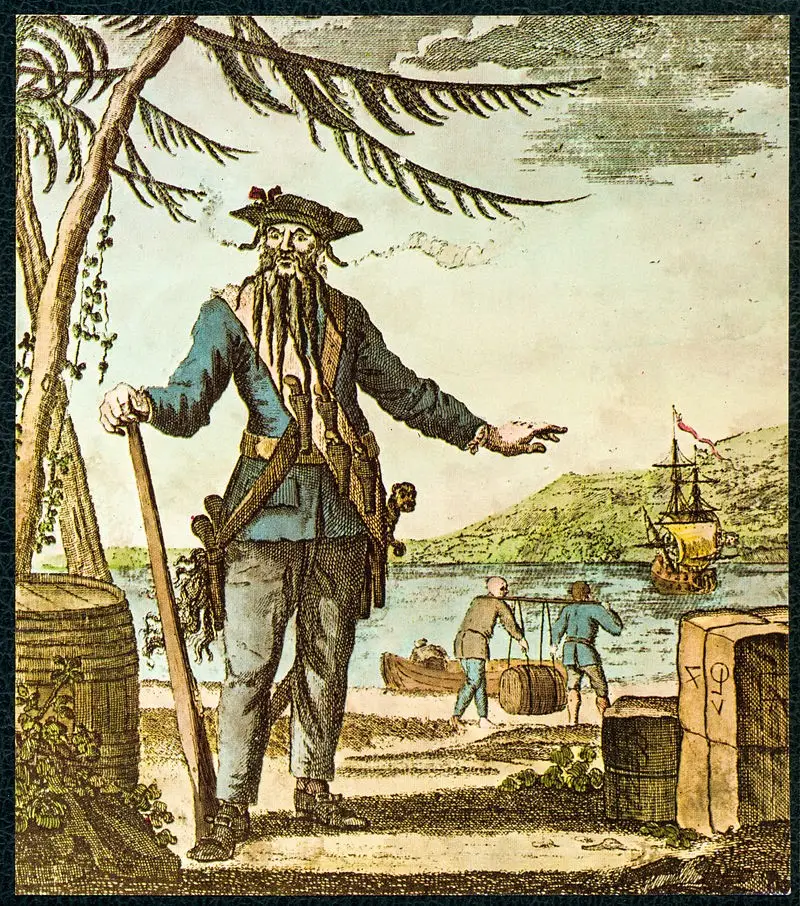
Edward Teach in an engraving from the first half of the 18th century
Edward Teach was an extraordinary personality even by the standards of the golden age of piracy. Although he was not able to fully enjoy the looted property, he was definitely lucky in terms of posthumous fame: historians, writers, artists and directors dedicated many works to him, making him one of the most recognizable personalities of the era. Books and films dedicated to him continue to be published in our time. What did he do to deserve such attention?
Origin
Little is known about Blackbeard's early life. It is generally accepted that he was between 35 and 40 years old at the time of his death, placing him around 1680. In records of the time, his name is most often given as Blackbeard, Edward Thatch, or Edward Teach, and it is the latter that is most often used today.
One early claim is that his last name was Drummond, but the lack of any supporting documentation makes this unlikely. It was the custom of pirates to use fictitious surnames when engaging in piracy so as not to tarnish the family name, and Teach's real name would likely never be known.
The rise of England's American colonies in the 17th century and the rapid expansion of the Atlantic slave trade made Bristol an important international seaport, and Teach most likely grew up in England's second largest city. He probably knew how to read and write, and communicated with merchants.
Author Robert E. Lee suggested that Teach was born into a respectable, wealthy family. He may have arrived in the Caribbean around the turn of the century on a merchant ship. The 18th-century author Charles Johnson stated that Teach was briefly a seaman active in Jamaica on privateering ships during Queen Anne's War, and that "he was often distinguished for his unusual boldness and personal courage." At what point in the war Teach entered hostilities is unknown.
New Providence
Privateer-turned-pirate Henry Jennings and his followers decided to use the then-empty New Providence Island as a base of operations in the early 18th century; it was located within easy reach of the Straits of Florida and its busy shipping lanes filled with European ships sailing to and from Europe.
New Providence Harbor could easily accommodate hundreds of ships and was too shallow for the larger Royal Navy ships to navigate. fleet. The island was not then the popular tourist destination it later became. Writer George Woodbury described it this way:
Law and order was unheard of; in New Providence, the pirates found a long-awaited respite.
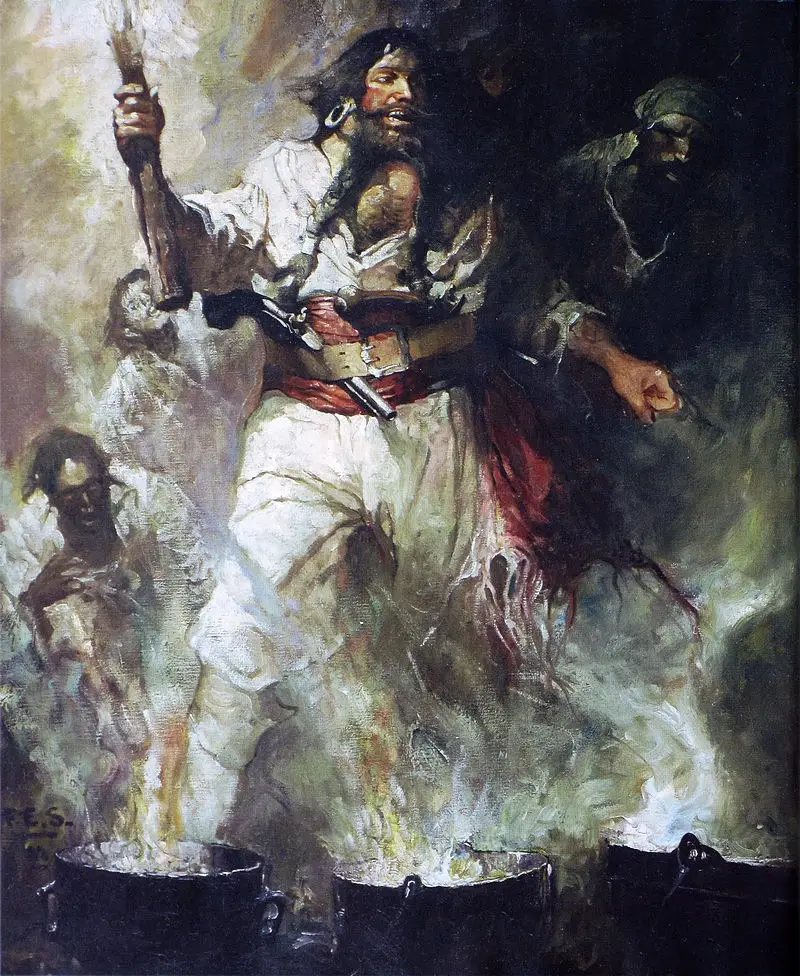
Blackbeard in Smoke and Flame, by Frank Schoonover
Teach was one of those who came to enjoy the benefits of the island. He probably moved there from Jamaica shortly after the Treaty of Utrecht in 1713 and, along with most of those who had been privateers during the war, took up piracy.
Around 1716, Teach joined the crew of Captain Benjamin Hornigold, a famous pirate operating in the waters of New Providence. In 1716, Hornigold appointed Teach as commander of a sloop, which he captured as a prize. Early in 1717, Hornigold and Teach, each a sloop captain, set sail for the mainland.
They captured a ship from Havana that was carrying 120 barrels of flour, and soon after took 100 barrels of wine from a Bermuda sloop. A few days later, they stopped a ship traveling from Madeira to Charleston, South Carolina. Teach and his quartermaster William Howard may have struggled to control their commands during this time. By this time they had become addicted to wine, and so on September 29, off Cape Charles, all they took from the Betty of Virginia before scuttling her with the rest of her cargo was wine.
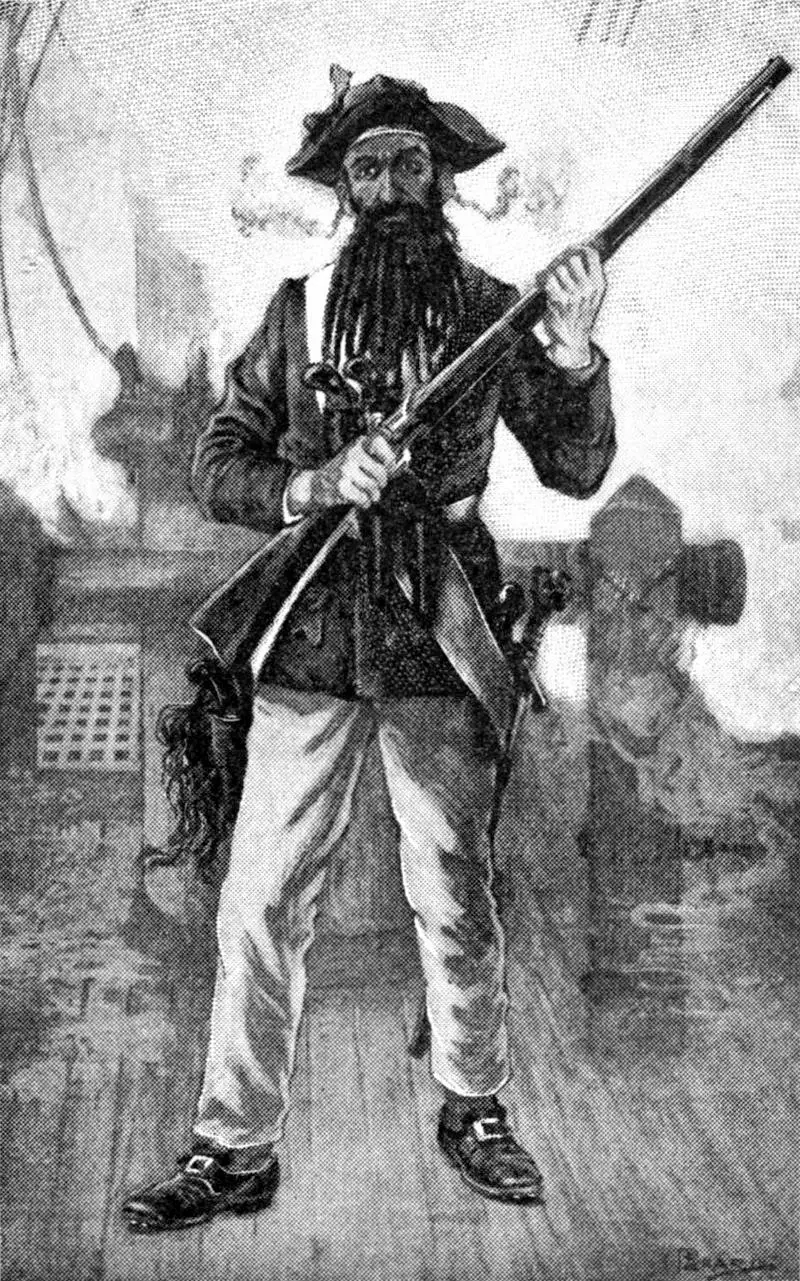
Blackbeard in a painting by an unknown artist, 1895
It was during this voyage with Hornigold that the earliest known report was made of Teach, recorded as a pirate in his own right and commander of a large crew. In a report made by Captain Matthew Mant while on an anti-piracy patrol in North Carolina, Thatch was described as commanding a "sloop of 6 guns and about 70 men."
In September, Teach and Hornigold clashed with Stead Bonnet. A landowner and military man from a wealthy family, he had turned to piracy earlier that year, but his crew of about 70 men were reportedly dissatisfied with his command. With Bonnet's permission, Teach took control of his ship, the Revenge. The pirate flotilla now consisted of three ships; "Revenge", accompanied by his old sloop and Hornigold's "Ranger". By October, another ship was captured, adding to the small fleet.
As a former British privateer, Hornigold attacked only his former enemies. For his crew, the sight of British ships passing unscathed, loaded with valuable cargo, was too much for him to bear, and at some point towards the end of 1717 Hornigold was demoted.
It is unknown whether Teach had anything to do with this decision, but Hornigold soon retired from piracy. Hornigold took the Ranger and one of the sloops with him, leaving Teach behind. The two pirates never met again, and, along with many other inhabitants of New Providence, Hornigold accepted a royal pardon from Woodes Rogers the following June.
On November 28, 1717, two of Teach's ships attacked a French merchant ship off the coast of St. Vincent. They each fired a broadside into the bulwarks, killing several of the crew and forcing the captain to surrender. It turned out to be the Concorde, a large French ship from Guinea carrying a cargo of slaves. Teach and his crew sailed the vessel south along St. Vincent and the Grenadines to Bequia, where they disembarked the crew and cargo and converted the vessel for their own use.
The smaller of Teach's two sloops was retained for the Concorde's crew, who renamed her Unfortunate Encounter and sailed for Martinique. Teach may have recruited some of the slaves, but the rest remained on the island and were later captured by the returning crew.
Peak career
Teach immediately renamed the Concorde Queen Anne's Revenge and equipped it with 40 guns. At the end of November he attacked the Great Allen near St. Vincent. Teach forced a large and heavily armed merchant ship to surrender after a long battle. He ordered the Great Allen to move closer to shore, disembarked the crew and emptied the cargo holds. The ship was then burned and sank.
The incident was described in the Boston News Letter, which noted that Teach was in command of "a French ship of 32 guns, a brigantine of 10 guns, and a sloop of 12 guns." When and where Teach assembled the ten-gun brigantine is unknown, but by this time it is estimated that he commanded at least 150 men, divided into three ships.
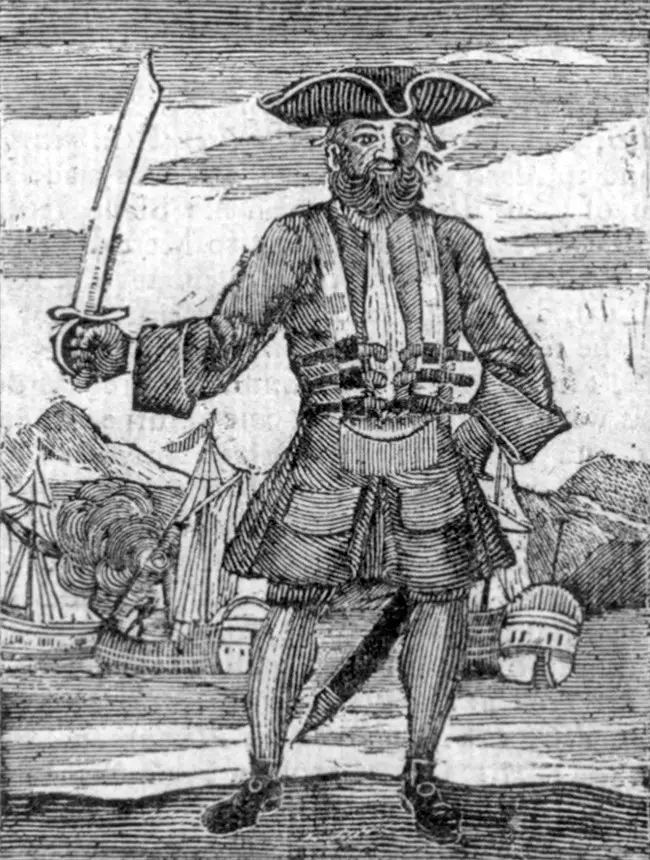
Portrait of Blackbeard from Charles Johnson's book "The Universal story robberies and murders committed by the most famous pirates"
On December 5, 1717, Teach stopped the merchant sloop Margaret off the coast of Crab Island, near Antilla. Captain Henry Bostock and his crew remained Teach's prisoners for about eight hours and were forced to watch as pirates plundered their sloop.
Bostock was given the Margaret back and was allowed to leave with his crew. He returned to his base of operations on St. Christopher Island and reported the incident to Governor Walter Hamilton, who asked him to sign an affidavit explaining the encounter.
Bostock's testimony details Teach's command of two vessels: a sloop and a large Dutch-built French "guineaman" with 36 guns and a crew of 300 men. The captain believed that the larger ship contained valuable gold dust, silver plates and "a very graceful cup", presumably taken from the commander of the Great Allen.
Teach's crew informed Bostock that they had destroyed several other ships and that they intended to sail to Hispaniola and await the expected Spanish Armada, presumably laden with money to pay the garrisons. Teach questioned Bostock about the movements of local ships and was not surprised when Bostock told him about the expected royal pardon from London for all pirates.
Captain Teach received the nickname Blackbeard due to the extremely thick hair that covered his entire face. His beard was of extravagant length; as for the width, it reached his eyes; he was accustomed to twisting it into little pigtails with ribbons and curling them around his ears.
Bostock's affidavit described Teach as "a tall, thin man with a very black beard, which he wore very long." This is the first recorded description of Teach's appearance; later accounts mention that his thick black beard was braided and sometimes tied with small colored ribbons.
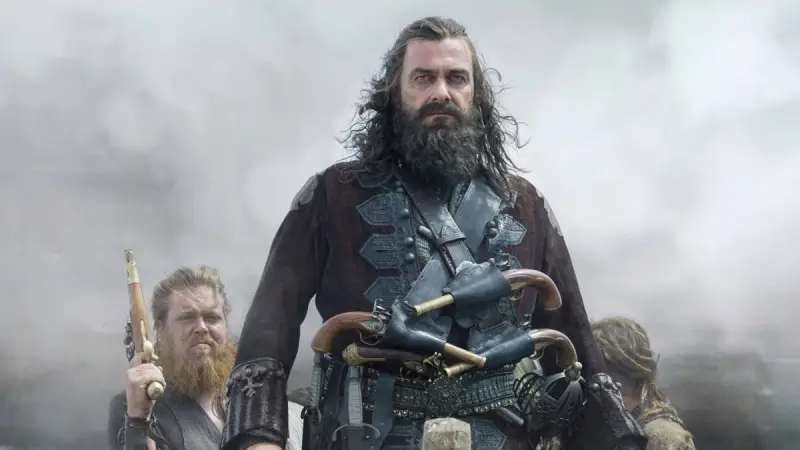
The image of Edward Teach in the series “Black Sails”, 2017
Johnson, in his book published in 1724, described Teach as "such a figure that the imagination cannot imagine a fury from hell to appear more fearsome." It is unclear whether Johnson's description of Teach was entirely true or embellished, but it is likely that Teach understood the importance of appearance to strike fear into the hearts of his enemies.
Teach was tall with broad shoulders. He wore knee-high boots and dark clothes, a wide-brimmed hat, and sometimes a long coat of bright silk or velvet.
Johnson also described Teach during the battle as wearing “a sling over his shoulders with three pistols hanging in their holsters like bandoliers; and struck lighted matches under his hat,” the latter apparently to emphasize the fearsome appearance he wished to present to his enemies.
To be continued ...
Information